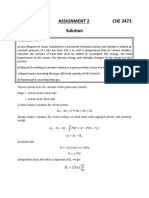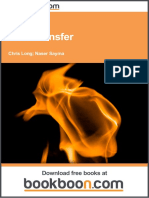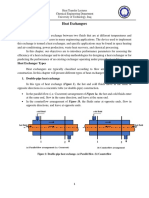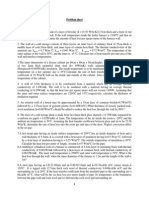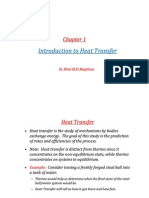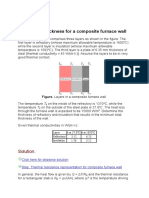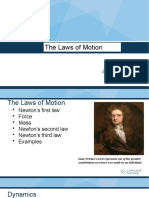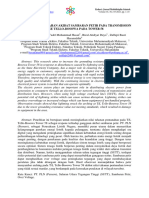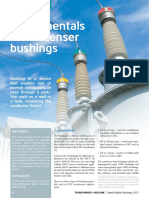Problem Solutions in Transport Phenomena: Heat Transfer Problems
For theory relevant to the heat transfer problems below, please refer to the book: Bird, R. B., Stewart, W. E., and Lightfoot, E. ., !"ransport #henomena!, $nd edition, %ohn Wiley, ew &ork'$(($). "he sol*tions below will also help yo* solve some of the problems in BSL 'an abbreviation often *sed for this +lassi+ tetbook based on the initials of its a*thors).
Maximum current in an electric wire
Problem
An electric wire with radius
r
0
of 0.50 mm is made of copper [electrical conductivity 5.! " !0
#
ohm
$!
m
$!
and thermal conductivity %&0 '()m *+,. -t is insulated )see fiure+ to an outer radius
r
!
of !.50 mm with plastic [thermal conductivity 0.%50 '()m *+,.
Figure:
Heatin of an insulated electric wire. The ambient air is at %&.0
o
/ and the heat transfer coefficient from the outer insulated surface tothe surroundin air is &.500 '()m
*+. 1etermine the ma"imum current in amperes that can flowat steady$state in the wire without any portion of the insulation ettin heated above itsma"imum allowable temperature of 2%.0
o
/.
Solution
Step. Thermal resistance representation for insulation and air -n eneral3 the heat flow is iven by
Q
T
(
R
th
3 where
T
is the temperature drivin force)thermal potential difference+. The thermal resistance for a cylindrical annulus is
R
th
ln )
r
!
(
r
0
+()
kL
+ and the thermal resistance for a fluid film at a solid$fluid interface is
R
th
!()
hA
+. Here3!

k
is the thermal conductivity3
h
is the heat transfer coefficient and
A
is the surface area for convection. The thermal resistances for the insulation and air film are in series as shown in the fiure below.
Figure:
Thermal resistance representation of insulation and air film 4ased on the above thermal resistance representation3 the heat flow is
Lr hkL
r r Rwhere RT T Q
thth
!0!0
!+(ln)
)!+where
k
is the thermal conductivity of the plastic insulation. Step. Heat flow due to current in wire The flow of an electric current results in some electrical enery ettin converted to thermalenery irreversibly. The heat eneration by electrical dissipation per unit volume is iven by
S
I
(
k
e
where
I
is the current density )in amp(m
+ and
k
e
is the electrical conductivity )in ohm
$!
m
$!
+.The total heat enerated within the wire is simply the product of
S
and the volume of the wire. Atsteady$state3 all this heat enerated within the wire by electrical dissipation must leave throuhthe wire surface and therefore the heat flow is iven by
Lr k I Q
e
0
)+Step. "pression for current 6n eliminatin
Q
from the above two e7uations3 the current density is
0(!!0!0
!+()!(+(ln)
+)
r hr k r r
T T k I
e
)%+6n multiplyin the current density by the cross$sectional area of the wire3 the current is obtained from
0(!!0!00
+()!(+(ln)
+)
r hr k r r
T T k r I Current
e
)8+9or the ma"imum current3 the temperature
T
0
must be ma"imied. Step. Substitution of numerical values
6n settin the temperature
T
0
to 2%.0
o
/ )i.e.3 the ma"imum allowable temperature for theinsulation+3 the ma"imum current that can flow throuh the wire may be calculated as !%.0#amp. The numerical values substituted in the e7uation are iven below. The values below may be chaned and the problem solution recalculated with the new values provided in consistent units. ;ariable nameSymbol;alue<nitelectrical conductivity
k
e
51000000
ohm
$!
m
$!
ma"imum temperature
T
0
93.0000
o
/ambient temperature
T
38.0000
o
/outer radius
r
!
0.001500
mwire radius
r
0
0.000500
m plastic thermal conductivity
k
0.35000
'()m *+heat transfer coefficient
h
8.50000
'()m
*+/alculated ;ariableSymbol;alue<nit=a"imum current!%.0#amp
Recalculate
Minimum thickness for a composite furnace wall
Problem
The wall of a furnace comprises three layers as shown in the fiure. The first layer is refractory)whose ma"imum allowable temperature is !800
o
/+ while the second layer is insulation )whosema"imum allowable temperature is !02%
o
/+. The third layer is a plate of ?.%5 mm thic@ness of steel [thermal conductivity 85 '()m *+,. Assume the layers to be in very ood thermal contact.%
Figure:
ayers in a composite furnace wall. The temperature
T
0
on the inside of the refractory is !%#0
o
/3 while the temperature
T
%
on theoutside of the steel plate is %#.&
o
/. The heat loss throuh the furnace wall is e"pected to be!5&00 '(m
. 1etermine the thic@ness of refractory and insulation that results in the minimumtotal thic@ness of the wall. Biven thermal conductivities in '()m *+: ayer
k
at %#.&
o
/
k
at !02%
o
/>efractory%.!?.%-nsulation!.5?%.!
Solution
Step. Thermal resistance representation for composite furnace wall -n eneral3 the heat flow is iven by
Q
T
(
R
th
and the thermal resistance for a rectanular slabis
R
th
x
()
kA
+3 where
T
is the temperature drivin force )thermal potential difference+3
x
isthe slab thic@ness3
k
is the thermal conductivity3 and
A
is the cross$sectional area of the slab. The thermal resistances for the three layers are in series as shown in the fiure below.
Figure:
Thermal resistance representation of composite furnace wall4ased on the thermal resistance representation for the composite furnace wall3 the heat flu"
q
is
%%%!!!0!0!!0
k x xT T k x xT T k x xT T AQq
)!+-n the refractory and insulation3 the thermal conductivity
k
varies with temperature. -f a linear variation is assumed3 then the arithmetic mean is to be used for the thermal conductivity. 8










